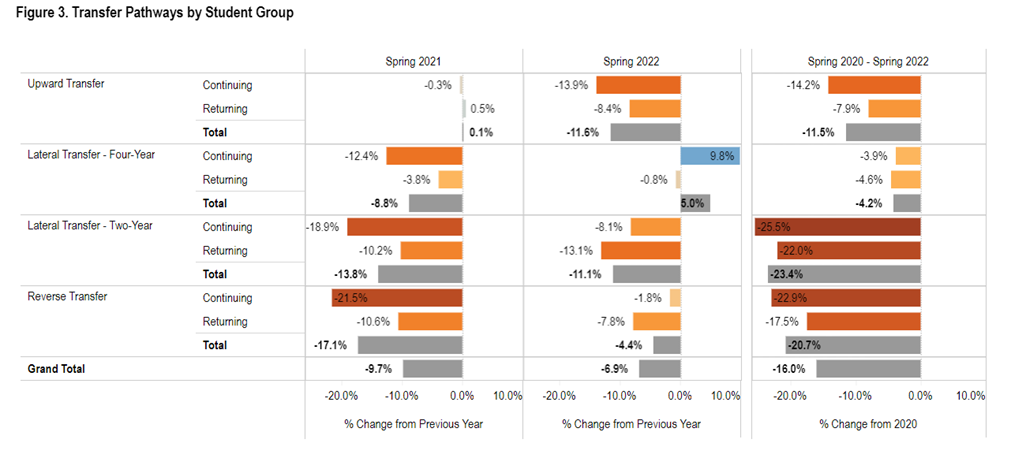- BLOG HOME
- »
- Research Services
- »
- Transfer Enrollment Drops 6.9% Over Last Year; 16% Decline Since 2020

Transfer Enrollment Drops 6.9% Over Last Year; 16% Decline Since 2020
In Major Shift, Upward Transfers Suffer 11.6% Decline This Spring
The latest COVID-19: Transfer, Mobility, and Progress report shows that in spring 2022, undergraduate transfer enrollment dropped another 6.9% over last year, resulting in a total two-year decline of 16% since the beginning of the pandemic. Non-transfer enrollment also continued a downward trend, but the one-year declines were not as steep as among transfer students (-3.8% for non-transfer students).
Most notable this spring are steep declines in upward transfer enrollment—most likely a ripple effect of pandemic-related sharp enrollment drops at community colleges, impacting freshmen, continuing, and returning students alike. After remaining stable last year, the number of students moving from a two-year to a four-year institution dropped 11.6%.
“This constriction of a key path to bachelor’s degree attainment is very concerning,” said Doug Shapiro, executive director of the National Student Clearinghouse Research Center. “Lower-income students seeking more-affordable degree options are being squeezed out.”
In an interview with Inside Higher Ed, Mikyung Ryu, director of research publications for the National Student Clearinghouse Research Center, said that while she expected the downward trend in upward-transfer enrollment to continue, she didn’t expect it to drop so far or so fast.
“We’re looking at a double-digit decline over one year,” Ryu said. “I’ve never seen that kind of decline in my adult career.” Ryu thinks these trends are here to stay, and that means “long-term consequences that may not be immediately visible, and not just for community colleges.”
Other Key Highlights:
- Four-year lateral transfer was the only transfer pathway to show growth, growing 5% to partly make up for enrollment losses seen last year (-8.8%).
- Transfers continuing from last fall decreased 5.3 percent while returning transfer students dropped 8.6 percent.
- Transfer enrollment continued to decline for both men and women but at a rate slower for men and faster for women this spring compared to last year (-5.5% vs. -13.7% last spring for men and -8.0% vs. -6.8% last spring for women).
- Transfer enrollment only grew among younger students (18 to 20, +3.0%), largely due to a growing number of students returning after stop-out (+14.3%).
All student groups declined in upward transfer enrollment, irrespective of age, gender, and race/ethnicity. The declines also affected all four-year colleges, regardless of selectivity level.
For more details, read the full report.
The COVID-19 Transfer, Mobility, and Progress Report series, with support from Ascendium Education Group and ECMC Foundation, identifies changes in student transfer pathways that are attributable to the pandemic by using historical data as the pre-pandemic baseline and the Clearinghouse’s current enrollment data.

We’re looking at a double-digit decline over one year. I’ve never seen that kind of decline in my adult career.
Mikyung Ryu
Director of Research Publications, National Student Clearinghouse Research Center
Additional Resources:



